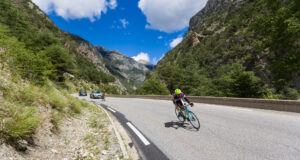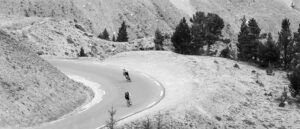Downhill Road Bike techniques can win races. It is that simple. As the level of talent increases, the margins at the finish line get smaller. Any time-saving methods you can use could be the difference between a podium finish or an “also-ran”.
Of course, downhill road bike techniques are not only for races. Descending safely and confidently should be of interest to anyone who rides a bike. So we invited Billy from Trivelo bikes to share his tips with us.
Implementing downhill techniques on a road bike
As a triathlete, I look for time advantages wherever I can. More speed and time gained downhill on the bike means more energy saved for the run, so it is always of interest. Many coaches will focus on uphill training and building vital muscles, but downhill is often ignored. Below are a series of tips for improving your downhill cycling technique.
Downhill Road Bike technique 1: Look down the road
Often when cycling, your focus is near the proximity of your front tyre. However, when cycling downhill, you need to be focusing way further down the road. If the disappearing point of the road is far enough away, 100-200 metres could be considered a minimum.
Spotting potholes or drain covers must happen much earlier when your speed shifts above 20mph. Consider the road surface further ahead and prepare your chosen line in advance. Subtle movements are all that is needed to change course as your speed increases.
Downhill Road Bike technique 2: Distribute your weight evenly.
When it comes to descending, you want to maintain your centre of gravity more evenly, which in reality means keeping more weight over your back wheel. You will need to retain some weight over the front wheel, or you may lose traction when you need to turn.
Adopting a cycling position using the drop handlebars will naturally bring you lower to the crossbar and distribute your weight. But, again, traction over both wheels is essential. An added bonus of riding on the drops is increased aerodynamics.
Downhill Road Bike technique 3: Maintain your pedalling cadence
Pedalling downhill may not come naturally if you are a nervous cyclist, as your intuition will be to cruise downhill. However, the purpose of maintaining some pedal cadence isn’t primarily about speed but about stability.
By keeping in high gear and maintaining an even pedalling pace, you adopt a more natural position on the bike. Cruising down in a superman aero position will leave you unstable and less reactive should things go wrong. Maintaining a cadence also means carrying more pace onto the flat sections if the gradient flattens out.

Downhill Road Bike technique 4: Lighten your weight on the saddle
You reduce the downward load on your saddle by pedalling, thus placing your weight at a lower centre of gravity on the bike. You don’t want the bulk of your weight placed on the saddle and handlebars where stability is compromised.
Few downhill sections are bullet straight, and so this more focused position will keep you smooth through turns. In addition, by not being heavily anchored to your saddle, you are more agile, able to switch your weight from side to side with ease.
Downhill Road Bike technique 5: Relax and breathe steadily
Being rigid and tense will make your body stiffen and less able to adapt to a quickly changing road surface. On the other hand, if you can maintain a relaxed upper body as you descend, you can smooth your turning and braking as required.
Your body acts as a form of suspension as the speed increases on your bike. Therefore, the more relaxed and confident you are, the more you will enjoy the experience and, in turn, the faster you will cover ground.

Downhill Road Bike technique 6: Give yourself plenty of space.
The same way a car needs a longer “runway” on a motorway, a faster cycle needs more space ahead. Unfortunately, no matter how good your new disc brakes are, they are no match for a surprise tractor across your path.
You may be tempted to keep close to the rider or car in front of you for air resistance, but you need to have enough room to brake and react to any incident ahead. So allow space for thinking and reaction time at the sacrifice of a little bit of speed. Don’t just tuck in and hope that everything in front will stay in front.
Downhill Road Bike technique 7: Be ready to brake
Cover your brakes at all times, so you can use them where needed. On a TT bike, you have to consider how well you know the road before going fully aero. Only move into an aero position when you have knowledge of the road, as you can no longer cover the brakes.
Being ready to brake doesn’t mean rubbing your brake pads the entire downhill run. Suppressing speed by having a forefinger covering the brake lever can result in excessive pad wear, braking drag and can even melt the pads on rim brakes.
Downhill Road Bike technique 8: Get your body position right.
The more aerodynamic you can make your body, the easier you will slip through the wind. Being aero doesn’t just mean getting your chin on the handlebars. The position of your knees and elbows are also critical. If body parts are sticking out, they act as a wind brake in the same way your torso does when you are not tucked over the handlebars.
Keep your body tight into the bike, creating as small a footprint as possible for the wind to hit. In contrast, if you find your speed building too fast and want to scrub some off, create more wind resistance by using your body as a natural wind brake.
About the Author
I’m Billy, and the founder of Trivelo Bikes Ltd. We are a UK based triathlon firm specialising in marketing and product testing exclusively in triathlon. We write regularly on our blog over at http://blog.trivelo.co.uk on all things triathlon if you have enjoyed this article and want to read more.
